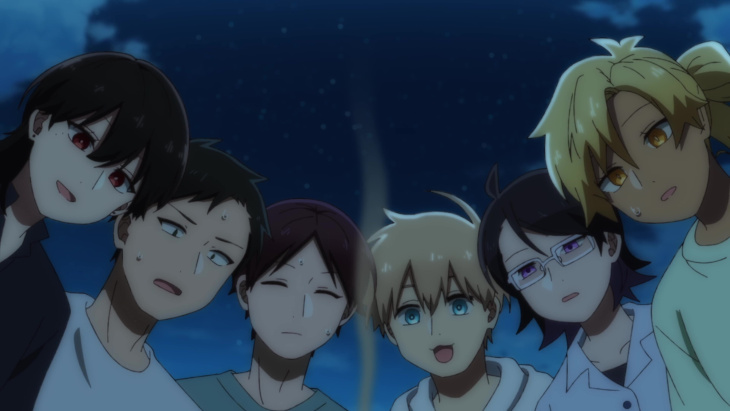
“No matter how many times I look, I still see three pretty boys.”
The premise of finding comedy in characters acting against the societal norms assigned based on their gender has been around for ages. You can even find it in the works of Shakespeare, but it comes with some potential pitfalls, as society becomes more accepting of different walks of life. That’s some pretty high brow considerations to bring to the table with this particular title, but for the first few episodes, that was key to the question I had bouncing through my mind. Is this show poking fun at the female characters for dressing like men, or is it poking fun at the male characters for their lack of flexibility?
The former approach is more close-minded and tends to undermine the comedic writing (i.e. look at practically any movie or show from the 80’s or 90’s that tries it. Those jokes haven’t aged well), whereas the latter can mine comedy from the insecurities of the leads. Fortunately, How I Attended an All-Guy’s Mixer primarily favors the latter approach. In theory, this should have been obvious given the demographics the show is targeting, but there was no way to be positive that it would be that competent. Ultimately, what we end up with is a show that plays with some interesting gender roles without feeling derisive, but struggles to have much of a hook beyond the basic cheesecake of its premise, if that.
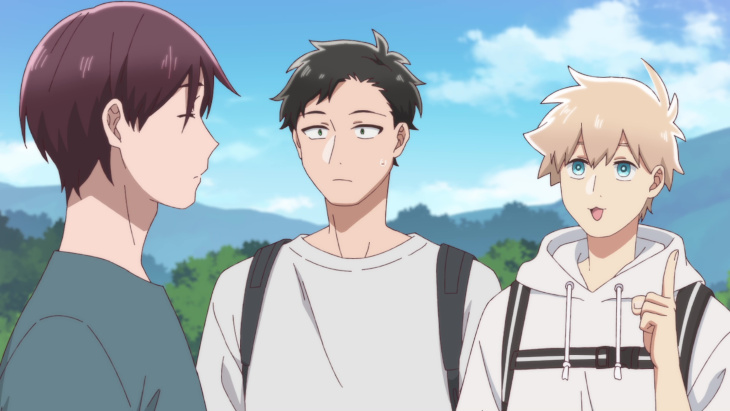
I feel like my ultimate conclusions about the show may seem a bit harsh, but there’s nothing inherently wrong with a comedy that doesn’t leave a lasting impact. The title of the show is a bit of a misnomer, as the main cast is split between three men and three women, but the hook lies in the idea that our female leads all work at a drag bishonen bar. Thus, they are regularly dressed to look like men. If it sounds like the show is looking to have its yaoi cheesecake and eat it too… Well, that’s a fair assessment. Though, as I mentioned before, there are merits to seeing how our male leads cope with a subversion of the gender dynamic they’re accustomed to. The problem is that the show mainly mines that for comedy, and there isn’t enough material to sustain the show from week to week. Plus, I won’t deny that I legitimately hated one of the male leads, and his presence put a damper on the entire show for me.
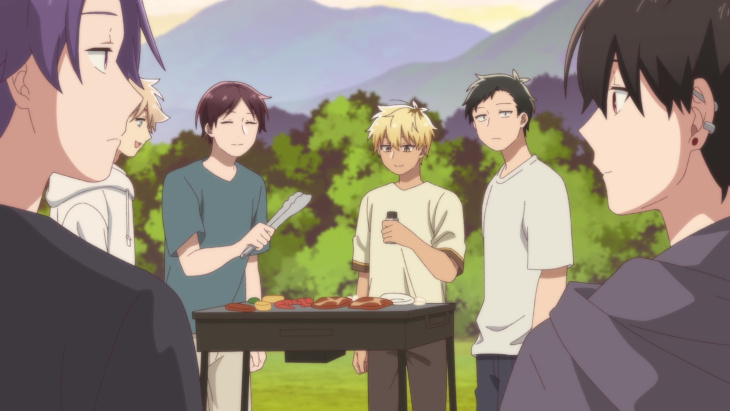
Our male leads are Tokiwa, Hagi and Asagii. Tokiwa, the black haired one, is the character we follow the most, and while he’s nervous about the dynamic between him and our cool and collected female lead, Suou, he generally maintains his composure, if just barely. Conversely, Hagi, the reddish-brown haired one, is a nervous wreck who regularly starts questioning his sexuality whenever he finds his stern female partner, Kohaku, to be cute. Finally, we have the blonde one, Asagi… I hate Asagi. Or more accurately, I hate the creative decisions Asagi represents. Asagi is the male character who is carefree and down for anything either his partner, Fuji, or the women as a whole suggest.
On paper, I should love this character, as his willingness to be flexible and go along with unfamiliar dynamics could have been refreshing. There’s just one problem. Asagi isn’t enlightened. He’s a dumbass. Fuji writes doujinshi in her spare time, but there is an extended plot where she gets Asagi to help her meet her deadlines without him realizing he’s working on porn. This goes on for an annoyingly long time. It’s not even a funny gag, and it completely undermines the more emotional elements they try to shoehorn into the plot. All the characters are lacking in depth, but Asagi is the one who feels most divorced from reality. Why is the one character who is completely open-minded also a complete himbo?
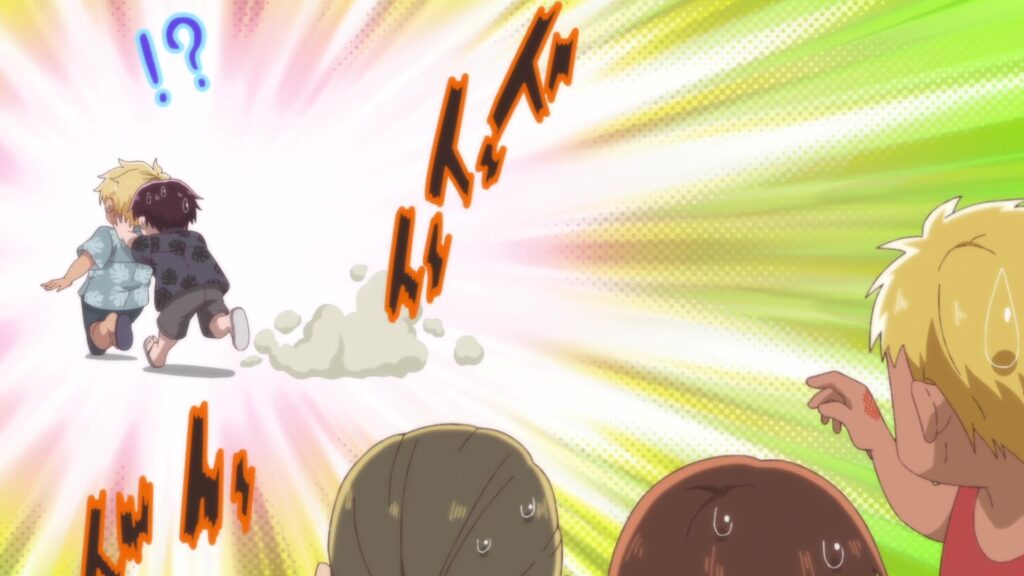
The production was helmed by Ashi Productions, a studio I’ve barely ever encountered. They’ve been around since the 70’s, but their filmography isn’t exactly a parade of recognizable titles. The most notable works they’ve produced in the past decade were Cutie Honey Universe and In Another World with My Smartphone. Next to those titles, How I Attended an All-Guy’s Mixer seems rather quaint. The animation is nothing special, often aiming for the basic middle-range of quality expected of comedy anime. It narrowly threads the line of looking cheaply animated without actually looking bad. It works fine for the comedic timing, though.
One of my issues with the writing of the show was that they lean heavily on certain jokes that I just don’t find funny, but once in a while the series would throw a curveball that would catch me off guard and I’d find it humorous. A key component of those moments was the show’s tactical use of its chibi art and its comedic timing. The series may have the budget of a grade school play, but it at least uses it to get the occasional laugh.
The music is forgettable, and I honestly skipped the OP and ED almost every time. It isn’t bad, but it aims for that boisterous, energetic tone that budget comedies seem to favor. I suppose better funded comedies use similar tones as well, but are more prone to making it work.
Before I wrap up, a few Notes and Nitpicks:
- While Asagi was my least favorite of the leads, Hagi’s storyline provides fierce competition towards the end of the season, as it hinges on neurotic overreactions and misunderstandings galore.
- Given the loose nature of the story, I’m surprised this wasn’t based on a 4-koma manga.
- The show favors the term “Drag King Bar” as a translation for Danso Bar, which I guess works. From what I understand, it evokes the wrong tone, but many of the concepts in the Japanese Bar scene don’t appear to have equivalencies in the Western lexicon. As someone who doesn’t live in Japan or visit bars, I feel doubly ill-equipped to try and devise terms for such an establishment.
How I Attended an All-Guy’s Mixer is the type of comedy that brings some good jokes and ideas to the table, but it doesn’t have enough of them to go around. I didn’t dislike it, but the material felt spread thin, and the characters are probably more abrasive in animation than they were on the original page. If you’re curious, it might be worth sampling the first episode or two, but if the comedy doesn’t click with you, then you’ve probably seen all the show has to offer.


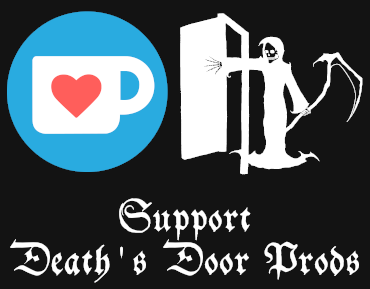

Add comment